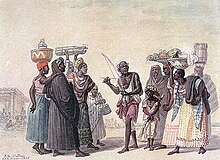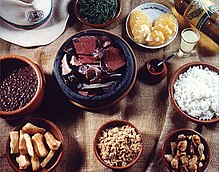Afro-Brazilian
Afro-Brazilian is a term given to Brazilians with African ancestry. Usually the term is used culturally rather than ethnically . This differs from the North American term African American .
Most of the descendants of Africans live outside Africa in Brazil, 55 to 57 million people. Only 7.5% of the Brazilian population claimed to be descendants of predominantly African slaves in the last census in 2010. Another 20% are descended from both Europeans and Africans. The greatest concentration of Afro-Brazilian people is found in Bahia , at over 80% .
history
After the Indian population proved unsuitable for working on the sugar cane plantations , the colonial motherland Portugal began to import Africans around 1550. More than 3 million slaves , about 37% of all Africans deported to America, were brought to Brazil.
During the colonial era of Brazil, slavery was the mainstay of the Brazilian economy, especially in mining and in the production of sugar cane . Slaves experienced great levels of physical and psychological violence from their "owners", with lashes being common. The Máscara de flandres were forced to torture slaves to keep them from eating the earth.
In 1835/1836 released Afro-Brazilian slaves were resettled in Africa. They were called retornados , Tabom in Ghana and Amarôs or Agudás in Benin , Togo and Nigeria . In the 19th century, a group of evangelical politicians in Great Britain lobbied for the abolition of slavery in Brazil. In addition to moral concerns, there were also solid economic interests: The colonies of Great Britain , in which slavery was prohibited, had a competitive disadvantage compared to Brazil. The British government therefore increased the pressure on Brazil and on May 13, 1888, achieved the final abolition of slavery. This made Brazil the last country in the western hemisphere to abolish slavery.
The Cemitério dos Pretos Novos memorial and research site is located in Rio de Janeiro , a slave cemetery where between 20,000 and 30,000 perished slaves were buried in mass graves.
Ethnic composition of the Afro-Brazilian people
The Africans who were deported to Brazil were essentially made up of two groups. The first group comes from Sudan and West Africa . They were mostly Yoruba , Fon , Ashanti , Ewe and Mandinka . They were big, had a relatively high culture, and were mostly forcibly settled in Bahia .
The second group were Bantu from Angola , the Congo and Mozambique , who were mainly settled in Rio de Janeiro , Minas Gerais and the northeast of the zona mata . During the last decades of slavery, black contract workers came to Brazil, mostly from Portuguese-speaking Africa.
The basic designation for black people is Negro (another designation, Preto , is pejorative), while mongrels are referred to as Pardo (gray-brown), for whose development of skin pigmentation a large number of names for mongrel categories have been formed over the past centuries.
religion
Most Afro-Brazilians are Christians , mostly Catholics . In addition, religions of African origin such as Candomblé have millions of followers, most of them Afro-Brazilian. The followers mainly focus on the large urban centers in northeastern Brazil such as Salvador da Bahia , Recife . Rio de Janeiro in the southeast is another center. There are also supporters in São Paulo and the state of Rio Grande do Sul , mostly immigrants from the northeast. In addition to Candomblé, there is also umbanda , which is a mixture of African beliefs and spiritualism .
In the past, the Afro-Brazilian religions were persecuted, later the religions were legalized by the Brazilian government.
Other variants besides Candomblé and Umbanda include Batuque , the Xangô cult in the northeast and Macumba .
Afro-Brazilian cuisine
The cuisine in the state of Bahia is dominated by Afrobahian cuisine, which consists of West and Central African , American-Indian cuisine and typical Portuguese dishes.
Typical dishes are vatapá and moqueca , both made with seafood and palm oil . Palm oil ( Azeite de Dendê ) is a tropical oil that is extracted from the oil palm that thrives in northern Brazil.
Another typical Brazilian dish is feijoada . It is usually made from black beans, rice, pork, and farofa . Originally a Portuguese dish, it was further developed by the African slaves and introduced some inferior ingredients: pig ears, feet and waist, and beans. It has been developed by all cultures and there are hundreds of types of preparation.
Capoeira
Capoeira is a martial art that was introduced by African slaves in the colonial times of Brazil. It is characterized by nimble and tricky movements. Capoeira comes from Angola. But there it is called capoeira rhoda. The fighting dance is accompanied by percussion music played on the berimbau , atabaques , agogô and xequerês .
music
The music of the Afro-Brazilians is based on the music of Africa . It emphasizes the percussion very strongly and is characterized by strong syncopations and polyrhythmic structures.
The Afro-Brazilians were more likely to maintain the African traditions than the slaves in North America, as the Portuguese slave owners largely allowed this. The Afro-Brazilian music has nevertheless strongly mixed with Portuguese and African influences.
Music styles with a particularly strong Afro-Brazilian component include the music of Candomblé , Samba , Maracatu , the music of Capoeira , Afoxê , Lundu and Batuque .
Afro-Brazilian instruments include atabaque , agogô , berimbau and xequerê .
literature
- Chirly dos Santos-Stubbe, Hannes Stubbe: Small Lexicon of Afro-Brazilian Studies. An introduction with bibliography. (= Cologne contributions to ethnopsychology and transcultural psychology , special volume 3). Vandenhoeck & Ruprecht, Göttingen 2014, ISBN 978-3-8470-0182-9 .
- Jeffrey D. Needell: The Sacred Cause: The Abolitionist Movement, Afro-Brazilian Mobilization, and Imperial Politics in Rio de Janeiro. Stanford University Press, Stanford 2020, ISBN 978-1-5036-0902-0 .
- Elaine Rocha: Racism in novels. A comparative study of Brazilian and South American cultural history . Cambridge Scholars Publ., Newcastle upon Tyne 2010, ISBN 978-1-443-82137-7 .
- Ricardo Salles: Episódios de historia afro-brasileira . DP & A Editora, Rio de Janeiro 2005, ISBN 85-7490-332-9 .
- Petra Schaeber: The power of the drums. Olodum and the Blocos Afros from Salvador / Bahia; Afro-Brazilian culture and "racial" relationships . Edition Tilsner, Bad Tölz 2006, ISBN 978-3-936068-97-9 (also dissertation FU Berlin 2003, reference to FU dissertations online).
- Martiniano J. da Silva: Racismo à brasileira. Raízes históricas; around novo nível de reflexão sobre a história social do Brasil . Garibaldi, São Paulo 1995, ISBN 85-7277-006-2 .
- Edward E. Telles: Racial Classification . In: Ders .: Race in another America. The significance of skin color in Brazil . University Press, Princeton 2004, pp. 81-84, ISBN 0-691-11866-3 .
- Jonathan W. Warren: Racial revolutions. Antiracism and Indian resurgence in Brazil. University Press, Durham, NC 2001, ISBN 0-8223-2731-7 .
See also
Individual evidence
- ↑ SIDRA, database query
- ↑ Pardo category includes Castizos, Mestizos, Caboclos, Gypsies, Eurasians, Hafus and Mulattoes . www.nacaomestica.org/. 2015. Retrieved April 15, 2015.
- ↑ Vilson Pereira dos Santos: Técnicas da tortura: Punições e castigos de escravos no Brasil escravista . In: Centro Científico Conhecer (ed.): Enciclopédia Biosfera . tape 9 , no. 16 , p. 2403 ( org.br [PDF]).





